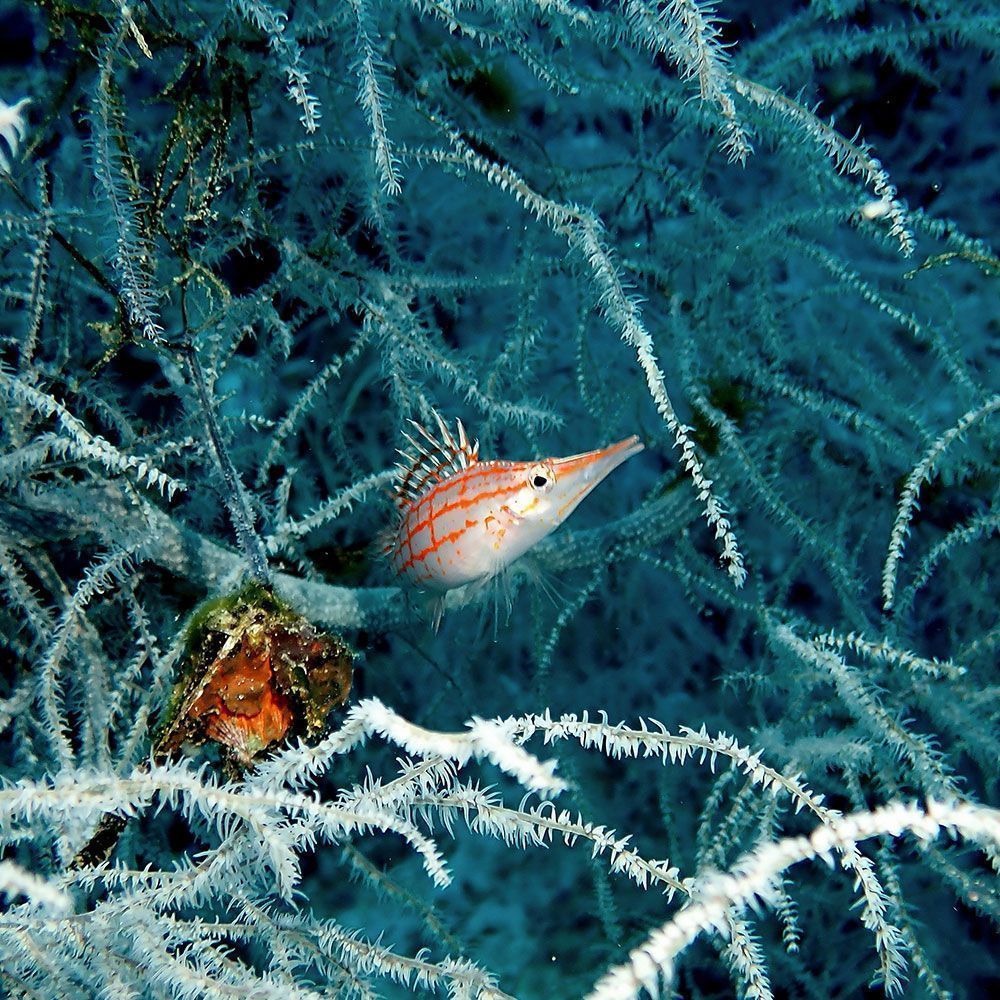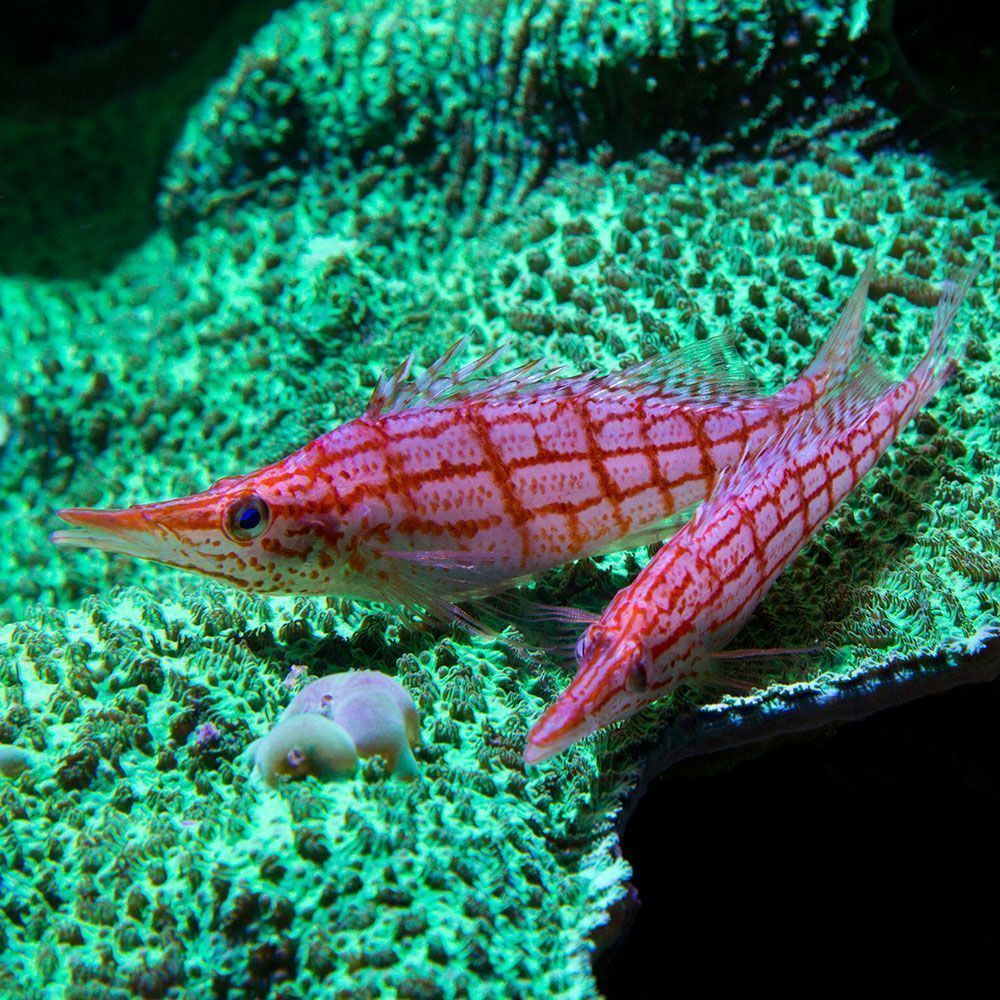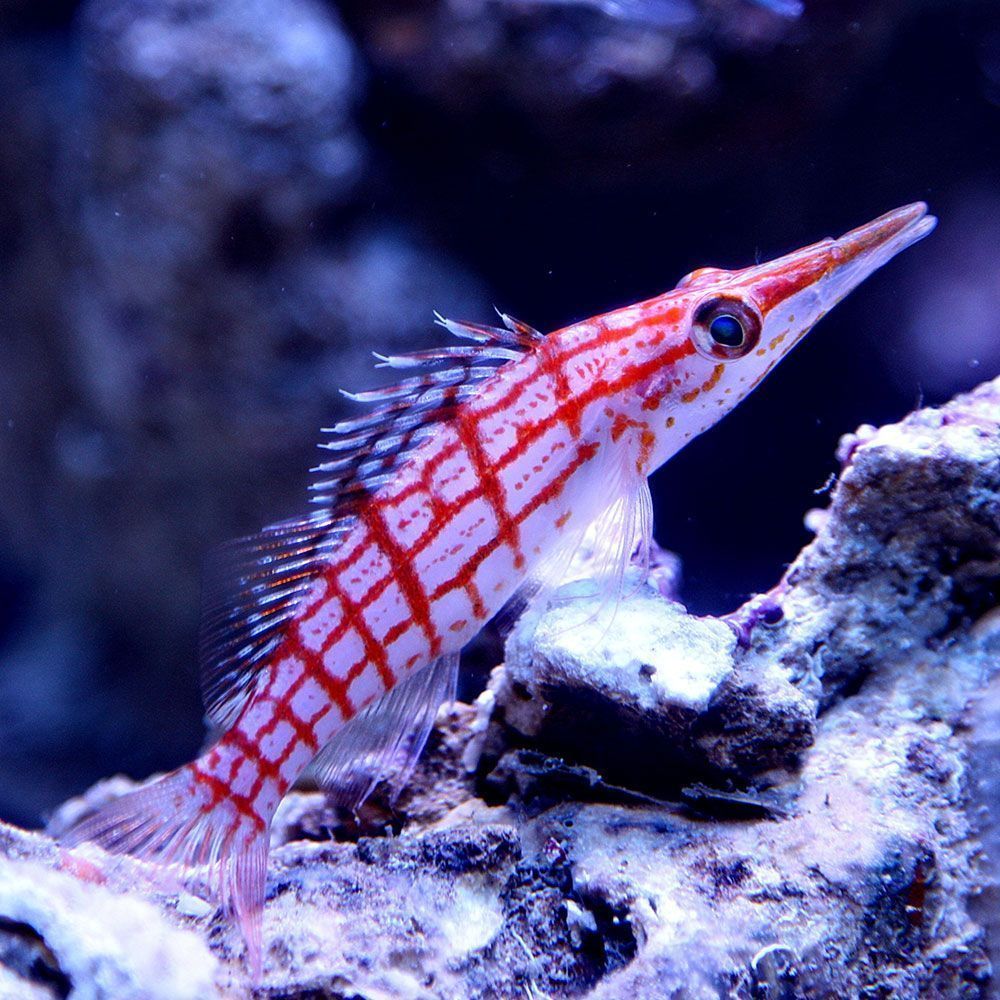If you want a lively and colorful addition to your saltwater aquarium, the longnose hawkfish is a fantastic choice!
The smart and energetic fish brings a lot of personality to your tank. It loves observing everything, including you!
Plus, it’s easy to take care of and would entertain you with unique acrobatics. If you enjoy unique-looking fish, this is a perfect fit for your aquatic family.
But before you grab yourself this pet, let’s know everything about it!
What is a Longnose Hawkfish?
A longnose hawkfish is a popular saltwater aquarium fish which is known for its long and pointed nose and gets its name from the same.
| Origin | Africa, Mozambique, Madagascar, Japan, Australia, Colombia, Costa Rica Red Sea, Indian Ocean, Pacific Ocean, West Atlantic New Caledonia, Noumea, Hawaiian Islands, Society Islands, Barrow Island, Scott Reef, Ashmore Reef, Lizard Island, Escape Reef, Christmas Island, Galapagos Islands, Southern Revillagigedos Islands, Cocos Island, Malpelo Island |
| Order | Perciformes |
| Family | Cirrhitidae |
| Scientific Name | Oxycirrhites typus |
| Common Names | Longnose hawkfish, Hawaiian hawkfish, and Pilikoa |
| IUCN Red List Status | Least Concern |
| Appearance | Opaque white cylindrical body, red grid red specks, long beaklike, canine teeth, large eyes, squared off tail fins |
| Size | Up to 13 cm (5 in) |
| Lifespan | 5-7 years in natural habitat. Up to 10 years with best care |
| Temperament | Aggressive. Male fish can get territorial towards larger female fish |
| Reef Safe | Reef safe but with caution |
| Tank Level | Top dweller |
| Water Temperature | 72-80 °F (22-27 °C ) |
| pH Level | 8.1-8.4 |
| Water Hardness | 8-12 dKH |
| Care Level | Easy |
| Minimum Tank Size | 40 gallons for one fish. 125 gallons for 2 or community |
| Tank Environment | Tank with perching and hiding spaces like corals, caves, and rocks. |
| Diet | Carnivores |
| Tank Mates | Larger, semi-aggressive fish |
What is the Natural Habitat of Longnose Hawkfish?
The longnose hawkfish, native to the Indo-Pacific and East Pacific regions, inhabits a wide geographical range from the Red Sea to Hawaii.
It extends northward to southern Japan and southward to parts of New Caledonia. In the eastern Pacific, it’s found from the Gulf of California to northern Colombia and the Galapagos Islands.
The fish prefers deep waters from 10 to 100 meters and likes steep outer reef slopes with strong currents. It perches on black corals and Gorgonians, waiting for small fish and invertebrates to feed on.
The fish is listed as Least Concern on the 2015 assessment of the IUCN Red List Status of Threatened Species.
Which family does Longnose Hawkfish belong?
The fish belongs to the Cirrhitidae family under the Perciformes order and is scientifically known as Oxycirrhites typus. It is a monotypic genus, i.e., it has only one species.
The fish is popular worldwide by a variety of names, like Hawaiian hawkfish, and pilikoa.
Fun Fact: The longnose hawkfish is special because it has a really long snout compared to other hawkfish. Its snout is about twice the length of its head!
How does Longnose Hawkfish look?

Now, if you’re intrigued by the captivating appearance of this fish, let’s explore its striking features in detail!
What is the Size of Longnose Hawkfish?
The adult longnose hawkfish can reach a size of up to 13 cm (5 in).
What is the Color of Longnose Hawkfish?
The longnose hawkfish has an opaque white body with thin red stripes forming a grid-like pattern, and there are horizontal red specks inside.
Its dorsal fin has red lines and specks. The anal fin is pale red, and the first part of the fin is white. Further, the pectoral and anal fins have red-yellow accents and clear to yellow pelvic fins.
What are the Features of Longnose Hawkfish?
The longnose hawkfish’s body is distinctively cylindrical. Its defining feature is its long beaklike nose about twice the length of its head.
It has uniform-sized canine teeth, slightly larger than the inner band of villiform teeth. The nocturnal species has large eyes and a plier-like mouth.
Unlike some similar-looking species like rockfish, scorpionfish, and lionfish, this hawkfish lacks prominent head spines.
It has hard and soft rays with tufts or cirri at the tip of each dorsal fin spine. There are also cirri on its nostril opening.
The pectoral fins are flowing and longer than usual, which helps the fish to perch. It has elongated unbranched lower rays.
How does a male and female Longnose Hawkfish differ?
The longnose hawkfish is a protogynous hermaphrodite. In simpler words, the young fry is always born female and changes into male as needed.
It’s challenging to distinguish males and females sexually.
The only few differences are that males are slightly larger, with potential red lower jaws, black stripe on dorsal fin, and black edges on pelvic and tail fins, although this isn’t universally confirmed.
What is the Behavior of Longnose Hawkfish in the tank?
The captivating longnose hawkfish is known to be the most peaceful hawkfish ever. However, male fish can become aggressive with larger females as they can try to change into males, leading to territorial disputes.
If conflict arises, separate the fish to prevent injuries. Watch for signs like circling, raising, lowering their dorsal fins, and locked jaws.
In aquariums, you’ll often notice the fish perched on the coral, watching every movement you make as you walk by.
It also likes camouflaging among coral reefs, especially black coral and red gorgonian sea fan or other decor. It’s semi-aggressive, getting along only with larger tankmates.
If it gets territorial, rearranging the tank helps. It enjoys chasing other species but rarely causes harm.
Though it’s highly acrobatic and a swift short-distance swimmer, it prefers waiting.
What is the Lifespan of Longnose Hawkfish?
Longnose Hawkfish live 5-7 years in its natural habitat. In well-cared-for aquariums, it can live up to 10 years.
Author’s Note: Introduce longnose hawkfish last in your tank to avoid territorial issues. In my experience, it’s better to add new fish during its sleep hours, typically not at night, to prevent conflicts.
Longnose Hawkfish Care Tips

If you’re eager to acquire this fish, let’s promptly explore how to care for it.
What should be the Tank Size of Longnose Hawkfish?
For a single longnose hawkfish, a minimum tank size of 40 gallons is acceptable. But if you add more of them, 125 gallons is ideal for comfort and less territorial tension. Make sure the tank has both horizontal and vertical space.
If you want a community tank with one longnose hawkfish and other non-territorial species, invest in a 125-gallon tank.
What should be the Water Chemistry for Longnose Hawkfish?
Though the fish is hardy, maintain the following water requirements to keep it healthy.
- pH Levels: 8.1-8.4
- Water Temperature: 72-80 °F (22-27 °C)
- Water Hardness: 8-12 dGH
- Ammonia: 0 ppm
- Nitrite: 0 ppm
- Nitrate: 0 ppm
- Synthetic Salt Level: 26-33 ppt
- Specific Gravity: 1.020-1.025
What should be the Tank Environment for Longnose Hawkfish?
To create an optimal setting for the fish, it’s important to replicate its natural Indo-Pacific habitat. Let’s explore how to design the perfect aquarium environment based on this.
Which type of Substrate does Longnose Hawkfish need?
The longnose hawkfish usually isn’t too picky about the substrate. But it thrives best in medium-sized gravel or fine sand substrates. It also appreciates live rock with lots of crevices.
Which Plants does Longnose Hawkfish need?
You can add saltwater plants to enhance oxygenation and beautify the tank. Here are some ideal plants for longnose hawkfish tanks.
- Halimeda
- Tufted joint algae
- Blue hypnea algae
However, avoid the following:
- Dragon’s tongue algae
- Red mangrove propagule
What Lighting does Longnose Hawkfish need?
Longnose Hawkfish are nocturnal, hiding during the day with their large eyes adapted for darkness.
Keep soft, dim lighting in the tank, allowing you to observe its behavior without causing discomfort.
What Décor does Longnose Hawkfish need?
The longnose hawkfish lacks a swim bladder, so it needs to rest periodically without buoyancy support. Therefore, the fish needs perching materials like sea fans or black corals. Otherwise, it will get stressed.
If you find this challenging, you can opt for coral skeletons or replicas instead. It also needs hiding space like caves or rocks.
What Filtration does Longnose Hawkfish need?
To maintain a healthy aquatic environment, proper and robust filtration, and regular water changes are crucial.
For nano/small tanks up to 40 gallons, it’s recommended to change 15% of the water bi-weekly.
Medium-sized tanks, ranging up to 90 gallons, should have water changes of 20-30% monthly, adjusting the frequency based on the bioload of the tank.
In the case of large tanks exceeding 100 gallons, a 20-30% water change every 6 weeks is sufficient once the tank has stabilized.
What is the Water Flow Rate for Longnose Hawkfish?
Ensure strong water movement in the aquarium to replicate the natural habitat of the fish.
Is Longnose Hawkfish Reef safe?
The longnose hawkfish is semi-reef safe. Its perching habits can damage coral polyps. So, choose the corals carefully, as they may be harmed by the stings of anemones and Catalaphyllia.
You can instead offer replica coral structures resembling the gorgonians for the species to perch on.
Care Tips
- When acclimating new fish, turn off aquarium lights, float the sealed bag in the tank for 15 minutes to match temperatures, and consider using a bacteria booster for a smooth transition.
- Watch out for their jumping tendencies; use a tight-fitting lid.
What does Longnose Hawkfish eat?
The longnose hawkfish is a carnivore, thriving on a diet of benthic inverts, planktonic crustaceans, and other small marine creatures in its natural habitat.
It particularly favors bottom-dwelling and free-swimming crustaceans in the wild. Its conical teeth can easily grasp them.
It is a skilled ambush hunter and patiently waits before striking to catch its prey. It demonstrates this behavior due to its lack of a swim bladder.
Its coloration fades if not given a varied diet rich in meaty foods, which should be finely chopped according to its mouth’s size.
To avoid loss of color and keep your pet fish healthy, the ideal diet should include:
- Salmon
- Worms
- Mysis shrimp
- Fortified or live brine shrimp
- Fish
- Crab meat
- Flake food with color-enhancing properties
- Pellet with color-enhancing properties
- Freeze-dried foods
- Feeder shrimp
- Clam
- Squid
Juveniles require several feedings a day, while adults can be fed twice daily. However, you must not overfeed them as it can lead to water fouling, especially in smaller aquariums.
While live foods can be part of its diet, be cautious. This might lead to aggression, especially if the hawkfish perceives smaller tank mates as prey.
What are the Tank Mates for Longnose Hawkfish?
The longnose hawkfish is territorial and can be aggressive, especially towards smaller tank mates. If you want it to share space with other species, choose larger, similarly temperamental fish. Here are our top picks for compatible tank mates:
- Diamond watchman gobies
- Orange spotted gobies
- Blennies
- Basslets
- Banggai cardinalfish
- Copperband butterflyfish
- Yellow longnose butterflyfish
- Common clownfish
- Tomato clownfish
- Maroon clownfish
- Blue devil damselfish
- Domino damselfish
- Orchid dottybacks
- Flame angelfish
- Bicolor angelfish
- Coral beauty angelfish
- Bluestreak cleaner wrasse
- Melanurus wrasse
- Six line wrasse
- Anthias
- Blue-green chromis
- Dwarf angelfish (as long as they’re not too small)
- Regal tangs
Which Tank Mates to Avoid for Longnose Hawkfish?
Avoid housing the following together:
- Small fish and invertebrates (e.g.: peppermint shrimp and molting hermit crabs): Longnose hawkfish view them as prey. If it fits in its mouth, it’s likely to be consumed, leading to a loss of tank mates. They may also get hurt if the spiky fish swims by them at high speed.
- Another male or dominant female longnose hawkfish: These hawkfish are territorial, and males fight among themselves or with other bigger females. This usually results in aggression and potential death.
- Very aggressive fish or larger carnivorous species: They can swallow the hawkfish whole.
What are the Common Diseases in Longnose Hawkfish?
These fish are hardy and disease-resistant, with a low parasitic load. They often outlive other tank mates during disease outbreaks and tank crashes. But you must keep an eye out for the following:
| Disease Name | Causes | Symptoms | Treatment |
|---|---|---|---|
| Saltwater Ich | Parasitic protozoan – Cryptocaryon irritans. | White spots on fins and bodies, heavy breathing, scratching, twitching. | Quarantine and prophylactic dip. Copper, Chloroquine Phosphate, and UV sterilizers. |
| Columnaris | Bacterial Infection | Gray/white patches, fin fraying, lethargy, appetite loss | Improve water parameters, add antibiotics, reduce stress |
| Fin Rot | Bacterial Infection | Fraying and/or disintegration of fins, fin discoloration, appetite loss, drowsiness | Improve water quality, remove objects that may physically injure your fish, add antibiotics |
Quick Tip: Avoid freshwater dips and formaldehyde treatments for longnose hawkfish. Instead, prioritize a stable environment to ensure their well-being and health.
How to Breed Longnose Hawkfish?
Breeding longnose hawkfish in aquariums is challenging, and it’s often not worthwhile as the fry rarely survives to adulthood.
Overcoming Breeding Challenges & Pairing
Unlike other hawkfish species that form harems, longnose hawkfish tend to be monogamous. So, you only need one male and one female.
However, breeding is complex due to their territorial behavior. To increase the chances of success, you can introduce them to the tank as juveniles.
If both fish exhibit similar levels of aggression and size, they may see each other as rivals rather than potential mates.
In this case, ABORT BREEDING PLANS. Otherwise, you may lose your fish.
But if things work out, keep going with the following steps.
Creating Optimal Condition
To encourage spawning, provide a diet of high-quality food to the pair. Replicate their natural habitat by dimming the lights.
House the pair in a breeding tank, away from other species. Maintain water temperature of 79-81 °F (26-27 °C). Follow all other water chemistry of the main tank.
What is the Mating Process for Longnose Hawkfish?
Longnose hawkfish engage in mating rituals at sunset. The male approaches the female with its dorsal fin erect, and they engage in a twirling dance with brief rests due to their lack of swim bladders.
Just before spawning, they align side by side and swiftly ascend from the coral through the water vertically.
Males stimulate females to release eggs through nudging and body quivering. At the surface, they turn and flex to release eggs and sperm into the water together and return to the coral.
How do Longnose Hawkfish release their eggs?
Longnose hawkfish are demersal spawners, meaning their eggs sink to the bottom.
Spawning occurs near the surface, and fertilized eggs are carried by currents until they mature enough to settle on the reef.
These eggs can be challenging to locate, so be attentive.
What is the Fry Survival rate for Longnose Hawkfish?
Fry survival rates are low, as parents may exhibit aggressive behavior, leading to territorial conflicts and ruining the eggs.
It’s better to separate the eggs ASAP into a separate tank and rear them.
However, some aquarists say that they noticed the parents guarding the young brood and collecting food for them. Other than that, not much information is available as the fish stays mostly in its burrows during reproduction.
Breeding Tip: During spawning, the eggs and sperm form a buoyant cloud near the surface. To collect the delicate eggs without harming them, use a container instead of a net.
A word from FishInAquarium
The longnose hawkfish are wonderful additions to aquariums, bringing color, energy, and personality for a reasonable price!
Their striking appearance and playful demeanor enrich any marine setup, making them a delightful choice for enthusiasts.
With their disease-resistant nature, they’re low-maintenance and perfect for peaceful tanks.
If you enjoyed learning about the fish, share this knowledge with others and embrace the joy of nurturing these remarkable marine companions.
Should you need further assistance or have inquiries, don’t hesitate to get in touch via email.
Happy fishkeeping!


